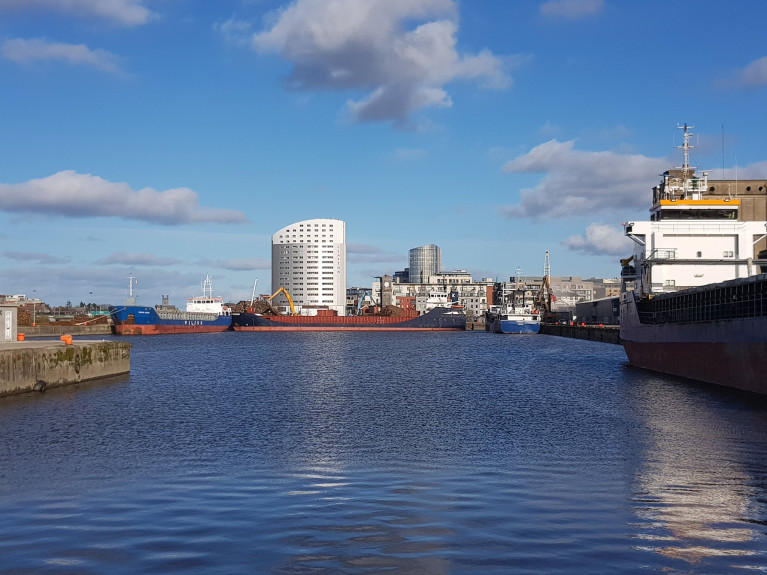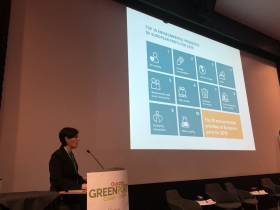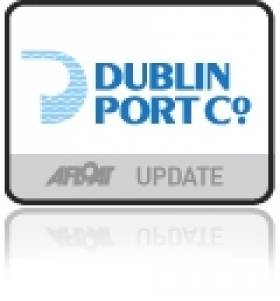Displaying items by tag: annual report
Shannon Foynes Port Company's Annual Report Reveals Port is Operating at Historically High Levels
Ireland's deepest sheltered commercial harbour, Shannon Foynes Port Company (SFPC) has reported another very strong year in 2021, with record earnings achieved for the year and profit before taxation exceeding €5.2 million for the first time.
The performance was down to a mix of recovery from Covid-19 impacts sooner than expected, a resurgent economy and the supply/demand imbalance in the energy generation sector, the report reveals.
With tonnage throughputs increasing by 16% to 10.9 million tonnes, turnover increased by 23.8% to €16 million (2020: €12.9 million). Tonnages were particularly strong in the agriculture and construction sectors, with the export of cement and related imports growing strongly.
Overall, SFPC’s general cargo terminals of Limerick and Foynes performed strongly, with year-on-year throughput increases of 9.9%, manifesting in these terminals now operating at historically high levels.
In addition to throughput and turnover growth, stringent cost management remained a core focus resulting in returning a significantly improved EBITDA margin of 47.5% (2020: 42.9%) and a historically high EBITDA of €7.6 million (2020: €5.6 million).
Commenting on the performance, Shannon Foynes Port CEO Patrick Keating said that despite challenges of 2022, he remained confident about the company’s future: “Notwithstanding the tragic events unfolding in Ukraine, we remain confident that there are significant opportunities to grow and expand the Port at the operating level. With an expanded business development function, we have identified targeted areas that will drive revenue growth over the short, medium and long term.”
Mr Keating said that Since 2011 – the base year of the company’s masterplan, Vision 2041 – tonnage at its general cargo terminals increased by 60%, even accounting for the COVID contraction. This performance is also reflected in the company’s balance sheet, with net assets increasing by 281% to €54m since 2010 and with annual net operating cashflow increasing by over 170% over the same period.
The CEO said that due to the increased tonnage throughputs projected in Vision 2041, the ongoing roll-out of the company’s investment programme is continuing at pace. Following the completion of Phase 1 at a cost of €12m, construction has now commenced on Phases II through to IV. These phases, costing a total of €33m, will involve the construction of 117m of new quay to join the East and West Jetties, infilling for associated quay set down together with the development of 38 hectares site at Foynes as a port business park. These represent the largest capital projects ever undertaken by the Company and are scheduled to complete in 2023.
He continued, the company will have a significant part to play in assisting the country’s transition to a low carbon economy due to its role as an international offshore renewable energy hub. “Our medium-term Capital Investment Program has been reviewed to ensure that the Port will have the necessary capacity for the medium term to accommodate this transition, particularly with regard to offshore renewables and deep water berth capacity,” he said.
Commenting on the results, David McGarry, Chairperson of SFPC, said: “The year recorded not only great financial success but also notable progress on several fronts with regards to SFPC’s Strategic Plan. With SFPC making strides internally, it also remains one of the foremost economic drivers for the Mid-West Region.”
Mr McGarry said that the Board had made significant progress on realising the objectives of the Strategic Plan 2021–2025. The company has now updated its objectives with the drafting of a 2022-2026 Strategic Plan, which has been delivered to the Department of Transport and the Department of Public Expenditure and Reform, with the report expected to be approved soon.
Ireland’s Sea-Fishing Fleet Slightly Reduced in 2020
The number of registered sea-fishing boats in the Irish fleet was only slightly reduced in 2020 as the industry was hit by COVID-related restrictions both here and abroad.
According to the Licensing Authority for Sea-fishing Boats’ Annual Report for 2020, the total of registered sea-fishing vessels was 1,998 — representing a 0.3% decrease the 2019 figure.
Of these, 179 were newly licensed and registered from a total of 220 applications. Licences for 1,721 vessels were renewed, 10 fewer than the previous year.
Meanwhile, total on-register capacity of the Irish fleet (including aquaculture vessels) — expressed in gross tonnes, a measure of volume, and kilowatts, a measure of engine power — was 64,912 GT and 189,169 kW. Respectively, these figures were decreases of 0.9% and 1% respectively on 2019.
At the end of 2020, a total of 14,122 GT and 12,022 kW was off-register, in other words held in the owner’s account and available for use as replacement capacity but not assigned to a vessel. Under current licensing policy, capacity that is off-register for two years or more is no longer available for use as replacement capacity.
The Licensing Authority for Sea-fishing Boats’s Annual Report for 2020 is available as a PDF to read or download HERE.
Shannon Foynes Sees Profits & Revenue Slip at State-Owned Port
Shannon Foynes Port Company which is state-owned, has reported a 7.6 per cent decline in turnover last year to €12.9 million as pre-tax profits fell from €4.9 million to €3.1 million due to the impact of the Covid-19 crisis.
Chief executive Pat Keating said it was a solid performance despite the unprecedented challenges faced by the facility, which is the country’s largest bulk port for non-container freight.
Earnings before interest, taxes, depreciation and amortisation (ebitda) for the year were €5.6 million, slightly up on the prior year despite a 94 per cent decline in throughput at the Moneypoint terminal due to the coronavirus pandemic.
Overall throughput at Shannon Foynes last year totalled 9.458 million tonnes, down 1.9 per cent or 185,000 tonnes versus 2019.
The Irish Times has further details of the mid-west port's performance.
The European Sea Ports Organisation today presented its annual Environmental Report for 2019 at the GreenPort Congress in Oslo, Norway.
The ESPO Environmental Report includes more than 60 different environmental performance benchmarks including figures on the green services to shipping (shore-side electricity, LNG and environmentally differentiated port dues) and the Top 10 Environmental Priorities of the European ports.
Air quality continues as the top environmental priority, followed by energy consumption. Air quality has become a key determinant of public “acceptance” of port activity in the years to come. Climate change, included in the Top 10 of the environmental priorities for the first time two years ago, is this year the third top priority after air quality and energy consumption. Almost eight out of ten European ports take climate change into consideration when they develop new infrastructure projects. Furthermore, 62% of ports strengthen the climate resilience of existing infrastructure and 47% of them have already dealt with operational challenges due to climate change. The relationship with the local community, which is of outmost importance for ports, is in position five this year. The 2019 citizen is stronger, better informed and more engaged. The local community is the new influencer and this is also for ports an important reality.
Transparency is clearly a high priority with 87% of the ports communicating their environmental policy to the stakeholders and 82% of them making it publicly available on their website. With regard to the green services to shipping, more than half of the ports are offering shore-side electricity for ships at berth (OPS), 48% of them providing high voltage electricity for seagoing vessels. One third of them has made LNG bunkering available, LNG being mainly provided by trucks (90%) and by barges (20%). In parallel, 56% of ports provide environmentally differentiated fees for ships that go beyond regulatory standards, with air emissions, waste and climate change being the main targets of these discounts.
In addition, 71% of the ports are certified with an environmental standard (ISO, EMAS, EcoPorts’ PERS) increased by 17% since 2013. 82% of ports have set up an environmental monitoring program, waste being the most monitored issue.
Aiming to further increase the transparency and accountability of the European port sector and to enhance the relationship of ports with their local communities, ESPO decided to publish the annual Environmental Report of the European port sector as from 2016. The report provides quality data on ports’ environmental performance and is becoming a point of reference for policy makers and stakeholders, including local communities, civil society, researchers and industry. 94 ports have been participating in this year’s report.
"In this year’s report, we see that ports continue to invest in green infrastructure such as shore-side electricity for ships at berth. However, we have to be aware of the increased investment costs and the technical challenges that prevent shore-side electricity from making today a strong business case. Increased costs relating to the connection with the grid and the electricity shortage at city or regional level are often additional barriers. Importantly, the price differential remains high due to level of taxation under EU Energy Taxation Directive and national levies applied to electricity price. Uncertainty on the use and the prospect of other promising technologies such as hydrogen makes it difficult to decide.
We encourage all ports to join EcoPorts in order to improve their environmental performance and better communicate their environmental policy. It will also broaden the sample of ports that feed into the annual benchmark performance of the sector.” says ESPO’s Secretary General, Isabelle Ryckbost.
The data for the report was obtained from the responses of 94 ESPO-member EU/EEA ports’ responses to the EcoPorts Self Diagnosis Method (SDM). The SDM is updated by EcoPorts’ members every two years.
The indicators included in this report feed into PortinSights, which is ESPO’s new tool for European ports to collect, share, compare and analyse their data. The digital platform includes throughput data, environmental data from EcoPorts and governance data.
Dublin Port Company Publish Annual Report & Accounts 2012
#DublinPort – The Dublin Port Company have published their Annual Report & Accounts for 2012 following a presentation of the accounts by Minister for Transport Mr. Leo Varadker to the Government at cabinet level last week.
As previously reported on Afloat.ie, the state's largest port launched a Masterplan last year that set out the development of Dublin Port's for the period from 2012 to 2040.
The 30 year Masterplan costing €600m presented a vision for future operations at the port and critically examines how existing land use can be used for the efficient running of the port through exporting and importing merchandise.
Four News Records in Irish Specimen Fish Committee's 2011 Report
#ANGLING - The Irish Specimen Fish Committee's annual report for 2011 features catch details for 587 specimen fish as well as four new records, according to The Irish Times.
The report comes ahead of the committee's annual awards event at the Red Cow Moran Hotel in Dublin on Saturday 3 March, recogising those anglers who work hard to catch and record the biggest fish of each of Ireland's species.
Those in line for awards include Terry Jackson, who caught a 2.1kh roach/rudd hybrid in the River Lagan; Dutchman Jan Vrieswijk who landed a 1.33kh blackmouth dogfish in Red Bay, Co Antrim; and Noel Lane for his 2.83kg thin-lipped mullet from Cork Harbour.
The Irish Times has more on the story HERE.



























































